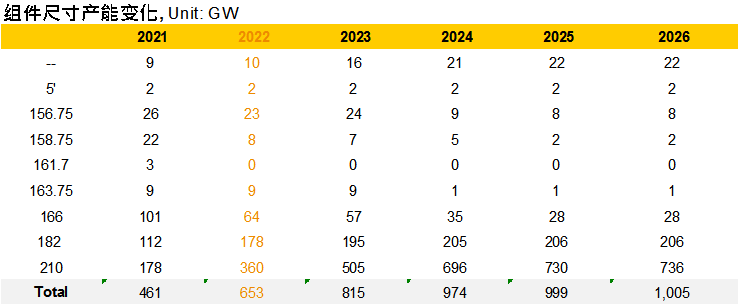Capacity of Solar Panel
Authoritative institutions predict that more than 55% of production lines are compatible with 210 battery modules by the end of 2022, and production capacity will exceed 700G in 2026
According to the industry supply and demand data released by PV Info Link in October, by the end of this year, the production capacity of large-size modules will account for more than 80%, of which the production capacity of compatible 210 modules will exceed 55%. With its excellent product strength and open and compatible features, the 210 technology platform is favored by more and more investors and manufacturers. In the future, with the maturity and application of advanced technologies such as N-type, the 210 technology platform will create more new possibilities for the development of the photovoltaic industry.
Large-sized components occupy an absolute advantage, and 210 continues to grow rapidly
According to the latest data from PV InfoLink in October, the production capacity of large-sized cells and modules will increase year by year in the next five years. From the battery side, the production capacity of large-size batteries will reach 513GW by the end of this year, accounting for 87% of the total. By 2026, the production capacity of large-size batteries will reach 1,016GW, accounting for 96%. The battery production capacity remains the same. By the end of this year, the production capacity of large-scale modules will reach 538GW, accounting for 82%. By 2026, the production capacity of large-scale modules will reach 942GW, accounting for up to 94%.
In the large-scale technology route, 210 is more favored by investors and manufacturers. The data shows that the expansion of 182 size cells and modules will stabilize after 2023. By 2026, the proportion of 182 cell production capacity will drop from 31% in 2022 to 28%, while the module production capacity will drop from 27% in 2022. By the end of 2022, the production capacity of compatible 210 cells and modules has become the mainstream, accounting for 57% and 55% respectively. By 2026, the production capacity of 210 cells will be It has increased to 69%, and the module production capacity has increased to 73%. The production capacity of 210-sized cells and modules will exceed 700GW.
Shipments of large-size modules also continued to climb. According to the third-quarter financial reports released by major photovoltaic companies, LONGi, Trina, and Jinko ranked the top three in terms of shipments in the first three quarters of 2022 with 30GW+, 28.79GW and 28.5GW respectively.
It can also be seen from the exhibit trends of the most influential exhibitions in the industry. From Intersolar Europe in Germany, to Intersolar South America in Latin America, and then to RE+2022 in the United States, 600W+ products have become the norm, sweeping the world. Both Chinese PV module brands and overseas PV companies in the United States, Japan, India, Europe, and Latin America have all exhibited 600W+ module products, and 210 modules accounted for more than 80% of all 600W+ products on display. With the increasing maturity of 600W+ products and the gradual increase in market penetration, 600W+ products have become the signature products of leading manufacturers in China and around the world.
Innovative and open, the 210 technology platform opens up a larger imagination space for the photovoltaic industry.
On the open 210 product technology platform, through the efforts of upstream industry chain partners, innovative breakthroughs in superimposed battery and module processes and the full application of automation, the speed of thinning far exceeds expectations. At present, the mass production of 150μm silicon wafers has been fully realized, and it will continue to move towards 145μm and below. In the case of high raw material prices, it contributes to reducing silicon consumption and costs for enterprises.
At the same time, the 210+N type technology is developing rapidly, opening up a new direction for the system side to further reduce the system cost. It is understood that more than 90% of heterojunction manufacturers have chosen the 210 technology platform.
With the maturity and breakthrough of N-type technology, the module power breakthrough of 700W is just around the corner, and the number of products built on the 210 product technology platform is expected to grow rapidly, better meet the diverse needs of users, and open up new paths for cost reduction and efficiency enhancement.
Post time: Nov-11-2022

